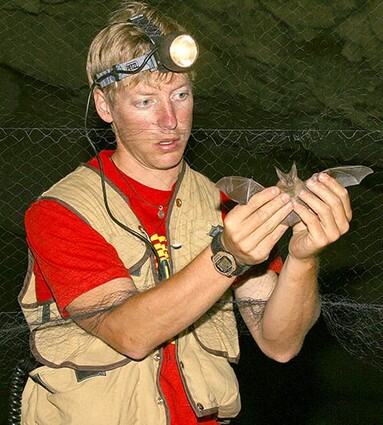Citizen scientists needed!
Last updated 8/20/2019 at Noon
Keeping up with bats is not an easy job. People who study bats don’t sleep during the normal times of most human beings. All our bats are nocturnal — local residents as well as visitors — so bat people are up all night long. Tom Rodhouse of Bend, a regional wildlife ecologist for the National Park Service, is one of those people — and he needs your help.
Tom started studying our bats back in the 2000s, beginning at OMSI’s Camp Hancock, then on to South Ice Cave and Ft. Rock State Park. He placed mist nets in what he thought were bat flyways and did a land-office business live-trapping them. He identified local bats and those that fly in from other locations to spend summer here pigging out on our moths and other nocturnal insects.
Hoary bats from down south and several of our local species work on moths and mosquitoes in summer, but desert-dwelling pallid bats pretty much single out Jerusalem crickets for their main meal. All summer long I receive phone calls about piles of funny-looking orange insect heads and black legs deposited on front porches.
Visiting the site and looking at the evidence, I determined that bats had left the mess, and one night, visiting a site near Sisters, I observed pallid bats coming into a porch overhang carrying crickets in their tail membranes. They’d roost over the doorway and proceed to munch on the bodies, spitting out the heads and legs.
In addition to Tom Rodhouse, there are other batty individuals who have contributed to our basic knowledge of these small flying mammals. People like biologist Pat Ormsbee, now retired after a career with the Forest Service, is a shining example.
Pat worked for the USFS in Eugene as a wildlife biologist and began surveying for bats as part of her job in about 1990. Bats intrigued her because they’re mammals that fly, echolocate, live for decades, and their young are called pups!
While working for the USFS, Pat completed graduate school at Oregon State University in 1995 and began conducting one of the first radio-telemetry studies of bats in Oregon. She tracked female long-legged bats to their daytime roosts and found them using big snags and hollow trees, which was an amazing discovery. She taught us that the bats were dependent on the biggest, baddest old trees in the forest to raise their pups.
You add that up with the other news about the welfare of cavity-nesting birds and other wildlife and you know why the USFS began placing “Wildlife Signs” on snags, in an effort to save them from wood-cutters.
In 2002, Pat started the bat grid program, and she started knocking heads and dragging people by the ear to start working together to save bats all across the Northwest. She got over 75 state and federal agencies, universities, NGOs, tribes, and consultants and recruited over 150 agency and citizen scientists to fund and do the monitoring of bats that was so desperately needed to get a pulse on bat populations. Tom Rodhouse came out of the woodwork to help Pat, they became fast friends, and have been working diligently ever since to turn the bat grid into what is now called the North American Bat Monitoring Program.
Enter Roger Rodriguez, who Tom beckoned to town a few years back to start up the Northwestern Bat Hub and run the North American Bat Monitoring Program out of OSU-Cascades. Roger, Tom, and Roger’s hired man Trent Hawkins, and still sometimes Pat and some OSU students are now doing amazing things all over the countryside trying to get a handle on these bats. They’ve got Oregon Department of Fish and Wildlife (ODFW), the Forest Service, BLM, and all kinds of other groups pulling together to run around and put bat detectors out on ground.
They’re running down the old bat grid locations and visiting new spots to find out what’s going on with our bats.
Trent Hawkins is recruiting and training volunteers to help go out in the desert and listen for spotted bats in the Central Oregon Spotted Bat Project. You can join in the fun!
Spotted bats are probably the coolest bats around, with huge pink ears, jet black in color with three white spots on the back. Sometimes they are called the Oreo cookie bat. Or the jackass bat. Or the death’s head bat. Depending on how you see the pattern when looking at their back. Spotted bats are so shy and solitary that Tom and the gang really didn’t know they were in the area until they figured out they could hear them calling better than catch and record them.
They’re high flyers and roost among sheer cliffs, but — unlike most other bats — their clicking calls can be heard by humans while the bats are flying about hunting for moths and other nocturnal flying insects in the canyons of Central Oregon. It is because of this audible call that Tom and Trent decided to start bringing citizen scientists in to help.
Biologists have limited understanding of spotted bat distribution and seasonal patterns in Oregon. What they do know, however, is that their calls are most commonly heard near the canyons and cliffs of eastern Oregon’s high desert in places like Smith Rock.
The dates and locations for training events are posted on the Spotted Bat Project site: https://osucascades.edu/HERS/northwestern-baBat people infot-hub/central-
oregon-spotted-bat-project.
At this training, volunteers will learn to distinguish a spotted bat call from other natural night sounds as well as how to identify potential high-quality spotted bat habitat for their future listening surveys.
Other topics of discussion will include safety, project logistics, and basic bat biology and natural history. Volunteer commitments can be as short as a one-evening training session and one night of survey.

















Reader Comments(0)